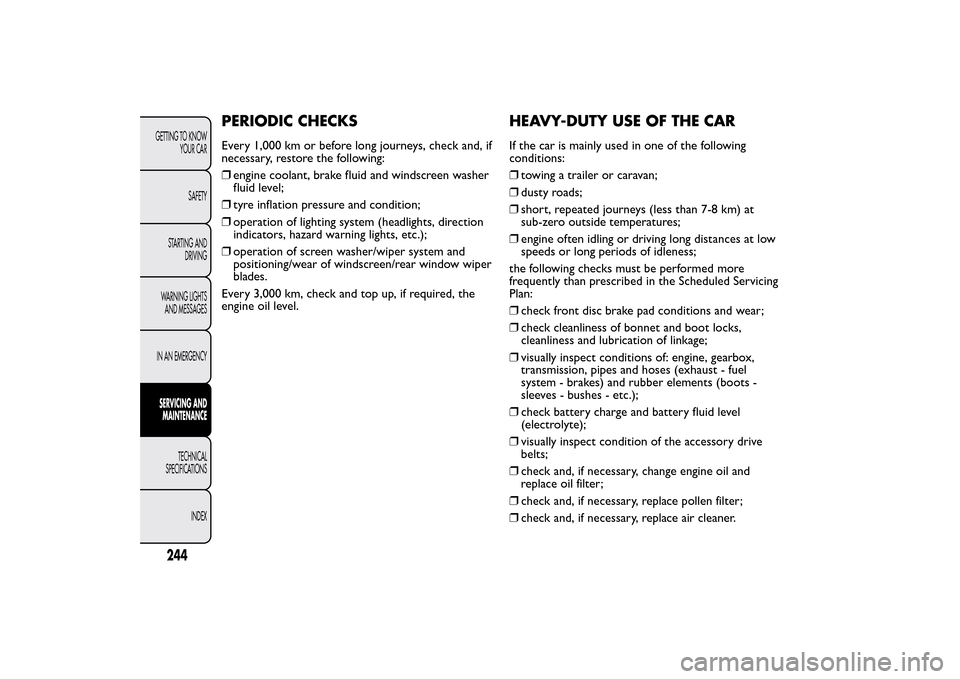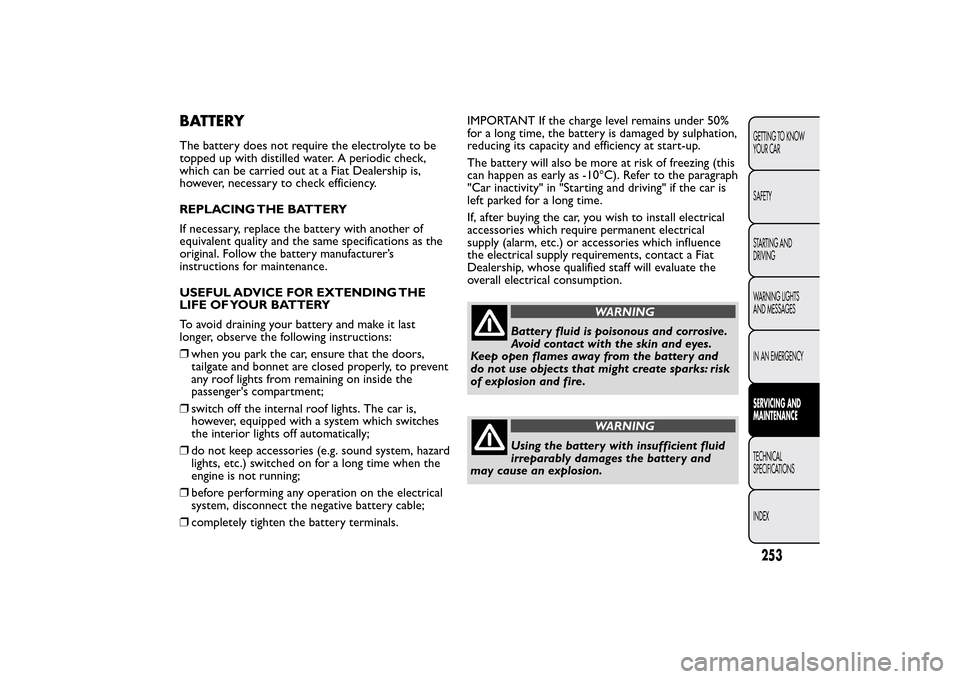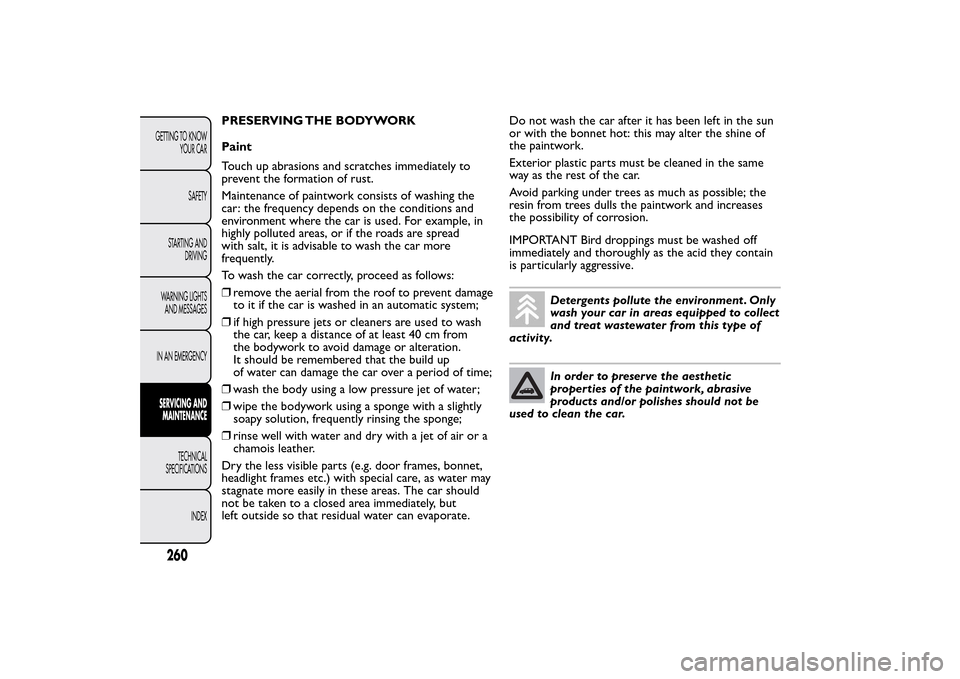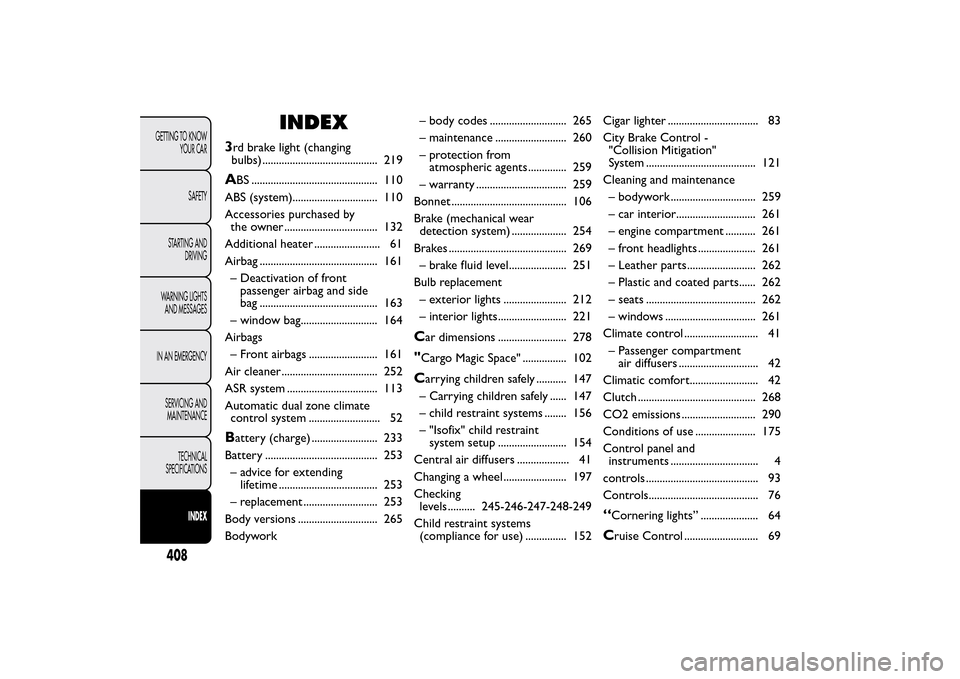2014 FIAT 500L LIVING bonnet
[x] Cancel search: bonnetPage 248 of 420

PERIODIC CHECKSEvery 1,000 km or before long journeys, check and, if
necessary, restore the following:
❒engine coolant, brake fluid and windscreen washer
fluid level;
❒tyre inflation pressure and condition;
❒operation of lighting system (headlights, direction
indicators, hazard warning lights, etc.);
❒operation of screen washer/wiper system and
positioning/wear of windscreen/rear window wiper
blades.
Every 3,000 km, check and top up, if required, the
engine oil level.
HEAVY-DUTY USE OF THE CARIf the car is mainly used in one of the following
conditions:
❒towing a trailer or caravan;
❒dusty roads;
❒short, repeated journeys (less than 7-8 km) at
sub-zero outside temperatures;
❒engine often idling or driving long distances at low
speeds or long periods of idleness;
the following checks must be performed more
frequently than prescribed in the Scheduled Servicing
Plan:
❒check front disc brake pad conditions and wear;
❒check cleanliness of bonnet and boot locks,
cleanliness and lubrication of linkage;
❒visually inspect conditions of: engine, gearbox,
transmission, pipes and hoses (exhaust - fuel
system - brakes) and rubber elements (boots -
sleeves - bushes - etc.);
❒check battery charge and battery fluid level
(electrolyte);
❒visually inspect condition of the accessory drive
belts;
❒check and, if necessary, change engine oil and
replace oil filter;
❒check and, if necessary, replace pollen filter;
❒check and, if necessary, replace air cleaner.
244GETTING TO KNOW
YOUR CAR
SAFETY
STARTING AND
DRIVING
WARNING LIGHTS
AND MESSAGES
IN AN EMERGENCYSERVICING AND
MAINTENANCE
TECHNICAL
SPECIFICATIONS
INDEX
Page 257 of 420

BATTERYThe battery does not require the electrolyte to be
topped up with distilled water. A periodic check,
which can be carried out at a Fiat Dealership is,
however, necessary to check efficiency.
REPLACING THE BATTERY
If necessary, replace the battery with another of
equivalent quality and the same specifications as the
original. Follow the battery manufacturer’s
instructions for maintenance.
USEFUL ADVICE FOR EXTENDING THE
LIFE OF YOUR BATTERY
To avoid draining your battery and make it last
longer, observe the following instructions:
❒when you park the car, ensure that the doors,
tailgate and bonnet are closed properly, to prevent
any roof lights from remaining on inside the
passenger's compartment;
❒switch off the internal roof lights. The car is,
however, equipped with a system which switches
the interior lights off automatically;
❒do not keep accessories (e.g. sound system, hazard
lights, etc.) switched on for a long time when the
engine is not running;
❒before performing any operation on the electrical
system, disconnect the negative battery cable;
❒completely tighten the battery terminals.IMPORTANT If the charge level remains under 50%
for a long time, the battery is damaged by sulphation,
reducing its capacity and efficiency at start-up.
The battery will also be more at risk of freezing (this
can happen as early as -10°C). Refer to the paragraph
"Car inactivity" in "Starting and driving" if the car is
left parked for a long time.
If, after buying the car, you wish to install electrical
accessories which require permanent electrical
supply (alarm, etc.) or accessories which influence
the electrical supply requirements, contact a Fiat
Dealership, whose qualified staff will evaluate the
overall electrical consumption.
WARNING
Battery fluid is poisonous and corrosive.
Avoid contact with the skin and eyes.
Keep open flames away from the battery and
do not use objects that might create sparks: risk
of explosion and fire.
WARNING
Using the battery with insufficient fluid
irreparably damages the battery and
may cause an explosion.
253GETTING TO KNOW
YOUR CAR
SAFETY
STARTING AND
DRIVING
WARNING LIGHTS
AND MESSAGES
IN AN EMERGENCYSERVICING AND
MAINTENANCETECHNICAL
SPECIFICATIONS
INDEX
Page 264 of 420

PRESERVING THE BODYWORK
Paint
Touch up abrasions and scratches immediately to
prevent the formation of rust.
Maintenance of paintwork consists of washing the
car: the frequency depends on the conditions and
environment where the car is used. For example, in
highly polluted areas, or if the roads are spread
with salt, it is advisable to wash the car more
frequently.
To wash the car correctly, proceed as follows:
❒remove the aerial from the roof to prevent damage
to it if the car is washed in an automatic system;
❒if high pressure jets or cleaners are used to wash
the car, keep a distance of at least 40 cm from
the bodywork to avoid damage or alteration.
It should be remembered that the build up
of water can damage the car over a period of time;
❒wash the body using a low pressure jet of water;
❒wipe the bodywork using a sponge with a slightly
soapy solution, frequently rinsing the sponge;
❒rinse well with water and dry with a jet of air or a
chamois leather.
Dry the less visible parts (e.g. door frames, bonnet,
headlight frames etc.) with special care, as water may
stagnate more easily in these areas. The car should
not be taken to a closed area immediately, but
left outside so that residual water can evaporate.Do not wash the car after it has been left in the sun
or with the bonnet hot: this may alter the shine of
the paintwork.
Exterior plastic parts must be cleaned in the same
way as the rest of the car.
Avoid parking under trees as much as possible; the
resin from trees dulls the paintwork and increases
the possibility of corrosion.
IMPORTANT Bird droppings must be washed off
immediately and thoroughly as the acid they contain
is particularly aggressive.
Detergents pollute the environment . Only
wash your car in areas equipped to collect
and treat wastewater from this type of
activity.In order to preserve the aesthetic
properties of the paintwork, abrasive
products and/or polishes should not be
used to clean the car.
260GETTING TO KNOW
YOUR CAR
SAFETY
STARTING AND
DRIVING
WARNING LIGHTS
AND MESSAGES
IN AN EMERGENCYSERVICING AND
MAINTENANCE
TECHNICAL
SPECIFICATIONS
INDEX
Page 412 of 420

INDEX
3rd brake light (changing
bulbs) .......................................... 219A
BS .............................................. 110
ABS (system)............................... 110
Accessories purchased by
the owner .................................. 132
Additional heater ........................ 61
Airbag ........................................... 161
– Deactivation of front
passenger airbag and side
bag ........................................... 163
– window bag............................ 164
Airbags
– Front airbags ......................... 161
Air cleaner ................................... 252
ASR system ................................. 113
Automatic dual zone climate
control system .......................... 52
Battery (charge) ........................ 233
Battery ......................................... 253
– advice for extending
lifetime .................................... 253
– replacement ........................... 253
Body versions ............................. 265
Bodywork– body codes ............................ 265
– maintenance .......................... 260
– protection from
atmospheric agents.............. 259
– warranty ................................. 259
Bonnet .......................................... 106
Brake (mechanical wear
detection system) .................... 254
Brakes ........................................... 269
– brake fluid level..................... 251
Bulb replacement
– exterior lights ....................... 212
– interior lights......................... 221
Car dimensions ......................... 278"Cargo Magic Space" ................ 102Carrying children safely ........... 147
– Carrying children safely ...... 147
– child restraint systems ........ 156
– "Isofix" child restraint
system setup ......................... 154
Central air diffusers ................... 41
Changing a wheel ....................... 197
Checking
levels .......... 245-246-247-248-249
Child restraint systems
(compliance for use) ............... 152Cigar lighter ................................. 83
City Brake Control -
"Collision Mitigation"
System ........................................ 121
Cleaning and maintenance
– bodywork ............................... 259
– car interior............................. 261
– engine compartment ........... 261
– front headlights ..................... 261
– Leather parts......................... 262
– Plastic and coated parts...... 262
– seats ........................................ 262
– windows ................................. 261
Climate control ........................... 41
– Passenger compartment
air diffusers ............................. 42
Climatic comfort......................... 42
Clutch ........................................... 268
CO2 emissions ........................... 290
Conditions of use ...................... 175
Control panel and
instruments ................................ 4
controls ......................................... 93
Controls........................................ 76
“Cornering lights” ..................... 64Cruise Control ........................... 69
408GETTING TO KNOW
YOUR CAR
SAFETY
STARTING AND
DRIVING
WARNING LIGHTS
AND MESSAGES
IN AN EMERGENCY
SERVICING AND
MAINTENANCE
TECHNICAL
SPECIFICATIONS
INDEX